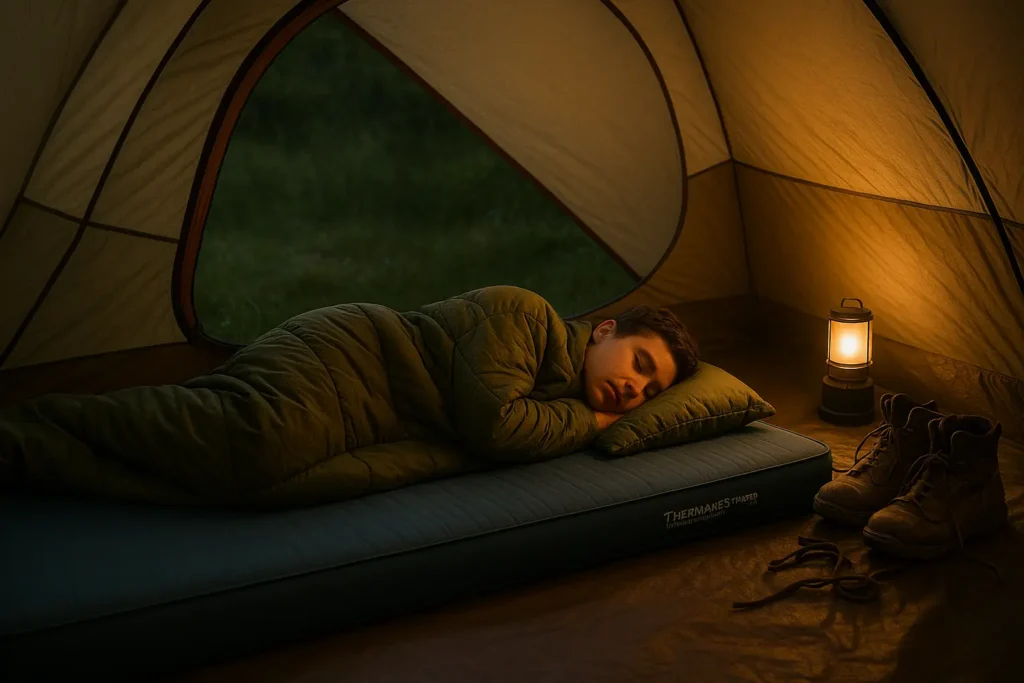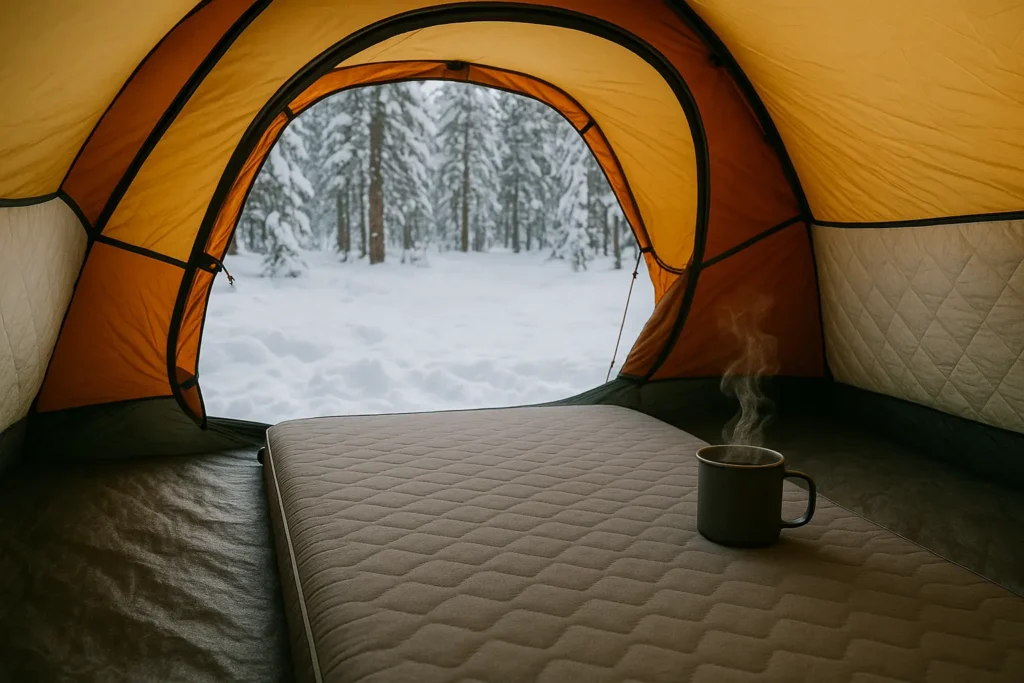I’ve camped in all kinds of weather and terrain, and if there’s one thing I never compromise on anymore—it’s sleep. A bad night on thin foam or a noisy air pad can ruin the whole vibe. That’s why I started using a self-inflating camping mattress. It gives me the right mix of comfort, insulation, and portability, especially when we’re out with the family.
But I remember asking myself early on: How thick should a self-inflating camping mattress be? After testing a few, I’ve found that 3 inches works best for me—it’s perfect for car camping and great if you’re a side sleeper. On backpacking trips, though, I switch to something thinner—around 1 to 2 inches—because space and weight matter more out there.
Choosing the right camping mattress thickness really depends on your setup: Are you backpacking or car camping? Do you sleep cold? What’s the terrain like? Your sleeping position, the R-value, and how much comfort you’re willing to carry all play a role.
In this guide, I’ll walk you through what’s worked for me and what to consider when picking the best self-inflating mattress thickness for your trips.
This article contains affiliate links. If you purchase through these links, I may earn a small commission at no extra cost to you, helping support my work. My recommendations are based on personal experience and thorough testing. Read my full disclosure for details.
Why Mattress Thickness Matters for Camping
From sore backs to cold nights, I’ve learned the hard way that mattress thickness really matters. It affects your comfort, warmth, and how easy it is to pack—especially when you’re switching between backpacking and car camping. The right self-inflating camping mattress thickness can make all the difference in how well you sleep outdoors.
Comfort and Support
No matter the price tag, comfort is everything when you’re sleeping outdoors. My go-to is a 3-inch self-inflating camping mattress—I can let out a little air to fine-tune the firmness, and I don’t feel the ground whether I’m on my back or side.
Thicker mattresses (3–4 inches) offer way more support and cushioning, especially for side sleepers or rough terrain. They’re great for car camping or when comfort is a top priority. For example, the Therm-a-Rest MondoKing 3D feels almost like a real bed. If you’re curious about other cozy options, I’ve also tried futon mattresses for camping—here’s how they compare for comfort.

Thinner pads (1–2 inches) are lighter and easier to pack—perfect for backpacking. Just know that a 1.5-inch pad might be okay for back sleepers on smooth ground, but it won’t cut it for side sleepers needing extra support.
Insulation Needs (R-Value)
Mattress thickness and insulation go hand in hand—and that’s where R-value comes in. The higher the R-value (on a scale of 1–7+), the better your self-inflating camping mattress will resist heat loss, which is key for cold-weather camping.

Thicker pads usually have more insulating foam, which means a higher R-value. Take the Exped MegaMat—it’s 4 inches thick with an R-value of 8.1, and it’s a lifesaver on snowy nights.
On the flip side, thinner pads like the Nemo Tensor (1.5 inches, R-value 4.2) are fine for mild weather, but they won’t keep you warm when temps drop. From my experience, if you’re camping below 40°F, aim for an R-value of 4 or higher to stay warm through the night. Of course, your bedding choice matters too—here’s how camping blankets vs sleeping bags best for keeping you warm.
Portability and Weight
Thinner self-inflating camping mattresses (1–2 inches) are super lightweight and compact—perfect for backpacking. I used a Sea to Summit Ultralight (just 1 inch thick and under a pound) while hiking the Appalachian Trail, and it saved space without killing my back.
But when I’m car camping with the family, I always go for a thicker mattress (3–4 inches) for extra comfort—even if it’s bulkier. You’re not hauling it far, so portability doesn’t matter as much.
In the end, it’s all about finding that balance between mattress thickness and how much weight or space you’re willing to carry.
Recommended Thickness by Camping Style
There’s no one-size-fits-all when it comes to self-inflating camping mattress thickness—it really depends on how you camp. After plenty of trial and error (and cold nights!), here’s what I’ve found works best:
Backpacking
When you’re out on the trail, every ounce counts—especially if you’re hiking long miles. For me, a self-inflating camping mattress thickness of around 2 to 3 inches is ideal. It’s light, packs down small, and still gives just enough comfort after a long day on your feet.
I’ve used the Therm-a-Rest ProLite (1.5 inches, about 1.2 pounds), and while it’s not plush like a bed, it definitely beats sleeping straight on the ground. Plus, it’s got an R-value good enough (around 2–4) for most three-season backpacking trips.
Honestly, I recommend testing your mattress on a quick overnight hike first. What works for one person might feel too thin for someone else—especially if you’re a side sleeper or have bony hips (ask me how I know).
Car Camping
With car camping, you don’t have to worry as much about weight—so go ahead and treat yourself to some real comfort. A self-inflating camping mattress thickness of 4 to 5 inches is honestly a game-changer, especially for longer trips or if you’re camping with family.
I used a 4-inch pad on a rocky campsite in Yosemite not long ago, and I slept like a baby. That little bit of extra cushioning made all the difference. For something even more plush, mattresses like the REI Co-op Camp Dreamer (4 inches, R-value 6.6) give you solid insulation and feel almost like sleeping at home.
You could even go thicker—5 to 6 inches—if you’ve got the space in your car or van. Air mattresses are common too, but personally, I prefer self-inflating camping mattresses because they’re quieter, warmer, and hold up better on uneven ground. If you’re converting your van for camping, you might be wondering what mattress sizes will actually fit—here’s what works for a Chrysler Pacifica and a Honda Odyssey.
Cold-Weather Camping
Camping in cold weather is a whole different beast. If you’re heading out in winter or up into the mountains, you’ll want a self-inflating camping mattress that’s both thick and well-insulated. I usually go with something around 3 to 4 inches thick, and I always check that it has an R-value of at least 4—ideally more.
One of the best I’ve used is the Exped MegaMat Duo—4 inches thick with an R-value of 8.1. It’s a bit bulky, sure, but totally worth it when the ground feels like ice. The extra foam and air inside thicker pads really help block out that chill from below.
Bottom line? Don’t skimp on mattress thickness or insulation when temps drop. You can have the warmest sleeping bag in the world, but if cold’s creeping up from the ground, you’re not sleeping well.
Key Factors for Choosing the Right Self-Inflating Camping Mattress Thickness
Figuring out the best self-inflating camping mattress thickness isn’t just about whether you’re backpacking or car camping. A few personal factors—like how you sleep, where you camp, and what you’re willing to carry—can make a huge difference in how comfortable you’ll actually be out there.
Sleeping Position & Body Type
From my experience, this is the biggest one. Side sleepers (and anyone with broader shoulders or hips) almost always do better with a thicker mattress, around 3–4 inches, so your hips and shoulders don’t dig into the ground all night. The Big Agnes Q-Core SLX (3 inches) is a solid example that balances support without being over the top.
Back sleepers can usually get by with a 1.5–2-inch mattress, since they don’t hit as many pressure points. Stomach sleepers tend to prefer something in the middle—2–3 inches—so they don’t feel awkwardly elevated.
Terrain & Campsite Conditions
The ground makes a huge difference. On rocky or uneven terrain, a 3-inch pad has saved me from waking up sore (I learned this the hard way camping in the Grand Canyon). But when I’m on soft, grassy sites, a 1.5-inch self-inflating pad is all I need—and it saves weight and space.
Budget & Durability
Not gonna lie—thicker mattresses usually cost more, often $100–$200, because they’re made with tougher, longer-lasting materials. Thinner models (around $50–$100) are cheaper but can wear out faster. Brands like Therm-a-Rest and Sea to Summit have been reliable for me, regardless of thickness.
Testing Before You Buy
Everyone’s comfort level is different, so if you can, test a few mattresses before buying. Try laying on them at a store or check real camper reviews to see how they hold up for comfort, durability, and insulation (especially their R-value) in the field. What feels fine for one person might feel like a rock slab to another.
The “right” camping mattress thickness comes down to how you sleep, where you’re sleeping, and how much weight or bulk you can deal with. Figure those out, and you’ll sleep a whole lot better under the stars.
Care and Maintenance of self-inflating Camping Mattresses
If you want your self-inflating camping mattress to last, a little upkeep goes a long way. I’ll be honest—I didn’t clean mine much at first, and it started to smell a little funky after a few muddy trips.
Here’s what I do now:
- Brush off dirt and debris after each trip so it doesn’t grind into the fabric.
- Spot clean stains or spills with mild soap and warm water (no harsh cleaners).
- Air dry it completely before packing it away—moisture is the enemy.
- Store it in a cool, dry place, away from direct sunlight, so the materials don’t break down.
A little care like this keeps your mattress clean, durable, and comfortable—and saves you from replacing it every couple of seasons.
FAQs
Here are answers to common questions about self-inflating camping mattress thickness, addressing user concerns directly.
Conclusion
Getting into camping can feel a little overwhelming at first, especially when it comes to gear. But honestly, once you figure out the basics—like the right self-inflating camping mattress thickness—the rest starts to fall into place.
Here’s the quick takeaway:
- For backpacking, stick with 1–2 inches to keep things lightweight and compact.
- For car camping, go for 3–4 inches for that extra comfort and insulation.
- For cold-weather camping, choose 3–4 inches with an R-value of 4+ so you’re not freezing at night.
Think about your sleeping position, the terrain, and your budget, and you’ll land on the right option. Personally, I’ve had good luck with brands like Therm-a-Rest, Exped, and REI Co-op, which all make durable pads that hold up trip after trip.
Once you’ve got the right mattress, the rest of camping—early mornings, fresh air, even those cold nights—starts to feel a whole lot easier. Cheers, and happy camping!
